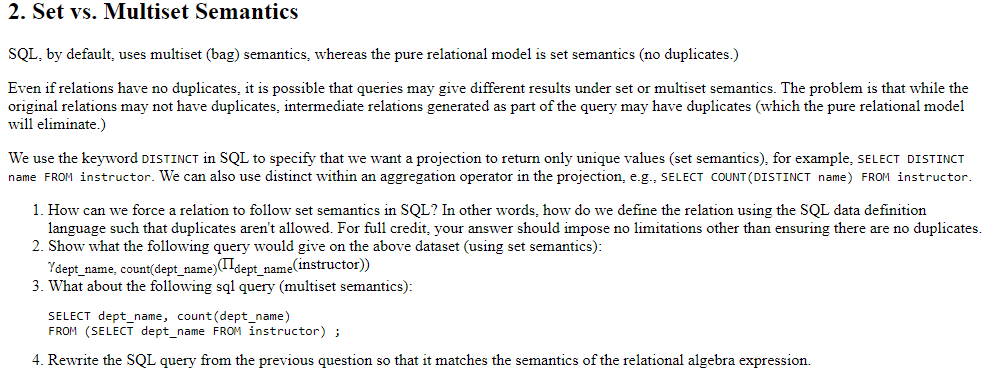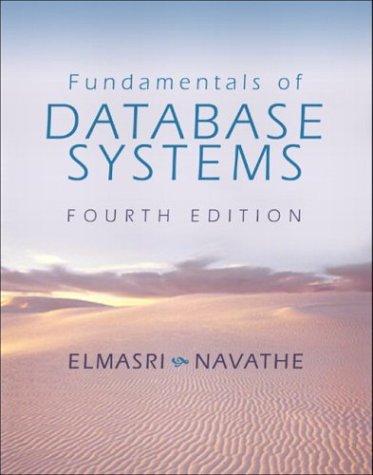
2. Set vs. Multiset Semantics SQL, by default, uses multiset (bag) semantics, whereas the pure relational model is set semantics (no duplicates.) Even if relations have no duplicates, it is possible that queries may give different results under set or multiset semantics. The problem is that while the original relations may not have duplicates, intermediate relations generated as part of the query may have duplicates (which the pure relational model will eliminate.) We use the keyword DISTINCT in SQL to specify that we want a projection to return only unique values (set semantics), for example, SELECT DISTINCT name FROM instructor. We can also use distinct within an aggregation operator in the projection, e.g.. SELECT COUNT(DISTINCT name) FROM instructor. 1. How can we force a relation to follow set semantics in SQL? In other words, how do we define the relation using the SQL data definition language such that duplicates aren't allowed. For full credit, your answer should impose no limitations other than ensuring there are no duplicates. 2. Show what the following query would give on the above dataset (using set semantics): Ydept_name, count(dept_name)(Ildept_name instructor) 3. What about the following sql query (multiset semantics): SELECT dept_name, count(dept_name) FROM (SELECT dept_name FROM instructor); 4. Rewrite the SQL query from the previous question so that it matches the semantics of the relational algebra expression. 2. Set vs. Multiset Semantics SQL, by default, uses multiset (bag) semantics, whereas the pure relational model is set semantics (no duplicates.) Even if relations have no duplicates, it is possible that queries may give different results under set or multiset semantics. The problem is that while the original relations may not have duplicates, intermediate relations generated as part of the query may have duplicates (which the pure relational model will eliminate.) We use the keyword DISTINCT in SQL to specify that we want a projection to return only unique values (set semantics), for example, SELECT DISTINCT name FROM instructor. We can also use distinct within an aggregation operator in the projection, e.g.. SELECT COUNT(DISTINCT name) FROM instructor. 1. How can we force a relation to follow set semantics in SQL? In other words, how do we define the relation using the SQL data definition language such that duplicates aren't allowed. For full credit, your answer should impose no limitations other than ensuring there are no duplicates. 2. Show what the following query would give on the above dataset (using set semantics): Ydept_name, count(dept_name)(Ildept_name instructor) 3. What about the following sql query (multiset semantics): SELECT dept_name, count(dept_name) FROM (SELECT dept_name FROM instructor); 4. Rewrite the SQL query from the previous question so that it matches the semantics of the relational algebra expression







